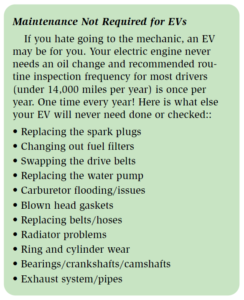Considering the rising costs of gasoline, is the initial price tag of an electric vehicle (EV) worth the extra money? EVs also impact the environmental less and offer other potential benefits, but what about hidden costs?
If you are thinking about getting a new car, you have likely considered buying an EV. Whether or not to invest in an electric vehicle is a personal decision and one not to be made lightly, considering the cost of a car these days.
An increasing number of them will be hitting the roads as the auto industry transforms from producing primarily internal combustion engine (ICE) vehicles to electric models. Zero-emission vehicles will account for 70 percent of new passenger vehicles globally by 2040.
ICE engines generally cost less upfront, people are familiar with the operating systems, and refueling is fast and easy to access. On the other hand, EVs are better for the environment, cheaper to charge than fuel with gasoline and less expensive to maintain. But what are the real numbers?
 ■ Maintenance: The US Department of Energy commissioned research that examined the maintenance costs of EVs versus gas-powered vehicles. After accounting for all aspects of service, the study found that light-duty gas vehicles cost 10.1 cents per mile to maintain, whereas similar battery electric vehicles could be serviced for 6.1 cents per mile. That is a difference of $8,000 if each car travels 200,000 miles, the average expected lifetime of a gas-fueled car. But EVs are made to last an average of 300,000 miles, putting the cost savings at $12,000.
■ Maintenance: The US Department of Energy commissioned research that examined the maintenance costs of EVs versus gas-powered vehicles. After accounting for all aspects of service, the study found that light-duty gas vehicles cost 10.1 cents per mile to maintain, whereas similar battery electric vehicles could be serviced for 6.1 cents per mile. That is a difference of $8,000 if each car travels 200,000 miles, the average expected lifetime of a gas-fueled car. But EVs are made to last an average of 300,000 miles, putting the cost savings at $12,000.
■ Fuel: Energy costs for gasoline, and especially electricity, vary from state to state. Currently, there is no gas tax for electric cars, although some states add a tax to EVs to replicate it. Since 2019, a special registration fee of $50 is assessed for plug-in EVs in Hawai‘i. According to AAA, the average fuel cost for an EV is between 4 and 5 cents per mile. If gas is $3 a gallon and your ICE car gets 35 miles per gallon, then it costs 8.6 cents per mile to operate, or nearly double the EV fuel cost. As we have seen this summer, gas prices have risen much higher than that at over $5 per gallon, making the cost for a gas-powered vehicle over 14 cents per mile.
Hidden costs associated with driving EVs
• The cost of a home charger. It is always cheapest to charge your car at home. Level 1 home chargers cost between $300 and $600. It can take up to 20 hours to charge your car. A faster Level 2 charger runs $500 to $700. Add $1,200 to $2,000 for the installation charge.
• Commercial charging. If you want to take your EV on road trips, if you travel more than about 100 miles from home or you forget to charge it, costs will rise significantly. Commercial charges cost three to four times that of residential rates; some charge a one-time fee to use them.
• The EV tax. Some states currently charge an EV tax to make up for the losses of taxable gas vehicles. Currently, Hawai‘i does not assess this tax.
• Deadhead miles. These are hours you may spend driving around, searching for a charger. The “EV Stations Hawaii” app utilizes the Hawai‘i State Energy Office’s database of publicly available EV charging stations, which is also available online at www.electricvehicle.hawaii.gov.
■ Subsidies: Most EVs and plugin hybrids are eligible for up to a $7,500 federal subsidy on the purchase price. The amount you get will depend on factors like battery capacity. Unfortunately, most Teslas are no longer eligible for the credit. Once the company sold 200,000 vehicles, the credit phased out. The Build Back Better Act, if passed into law, would include significant refundable tax credits that include Teslas. Currently, Hawai‘i does not offer state tax credits or rebates.
■ EV Fun Factor: Driving one can be thrilling; they can accelerate amazingly fast. They are also at the forefront of the self-driving car movement.
 Are EVs Really All That Green?
Are EVs Really All That Green?
The short answer is yes. But just because EVs have no exhaust emissions does not mean that there are no associated environmental impacts.
■ Power plants that rely that rely on coal to generate electricity emit carbon pollution. Energy generated by renewable resources such as wind and solar have an extremely small carbon footprint.
■ Cobalt and lithium are required in lithium-ion cells. Cobalt is mined largely in the Democratic Republic of Congo, where a large proportion of mines are unregulated. The mining produces waste that can leach into the environment. The smelting process can emit harmful air pollution. Lithium mining uses groundwater, reducing the amount available for farmers and herders in mining areas in Argentina, Bolivia and Chile.
■ Spent batteries are difficult to reuse and recycle. While 99 percent of lead-acid batteries are recycled in the US, only 5 percent of lithium-ion batteries are recycled. Some 12 million tons of lithium-ion batteries are projected to retire between now and 2030.
The Choice is Yours: Maybe you are convinced that EVs are the way to go. Or will you just sit back and hold onto the old SUV in your garage another year, watching as more and more EVs roll out? Before you make up your mind, take these variables and a plethora of others into account.
CSA (Society of Certified Senior Advisors)
1-800-653-1875 | www.csa.us
Blog posting provided by Society of Certified Senior Advisors, Apr 13, 2022

